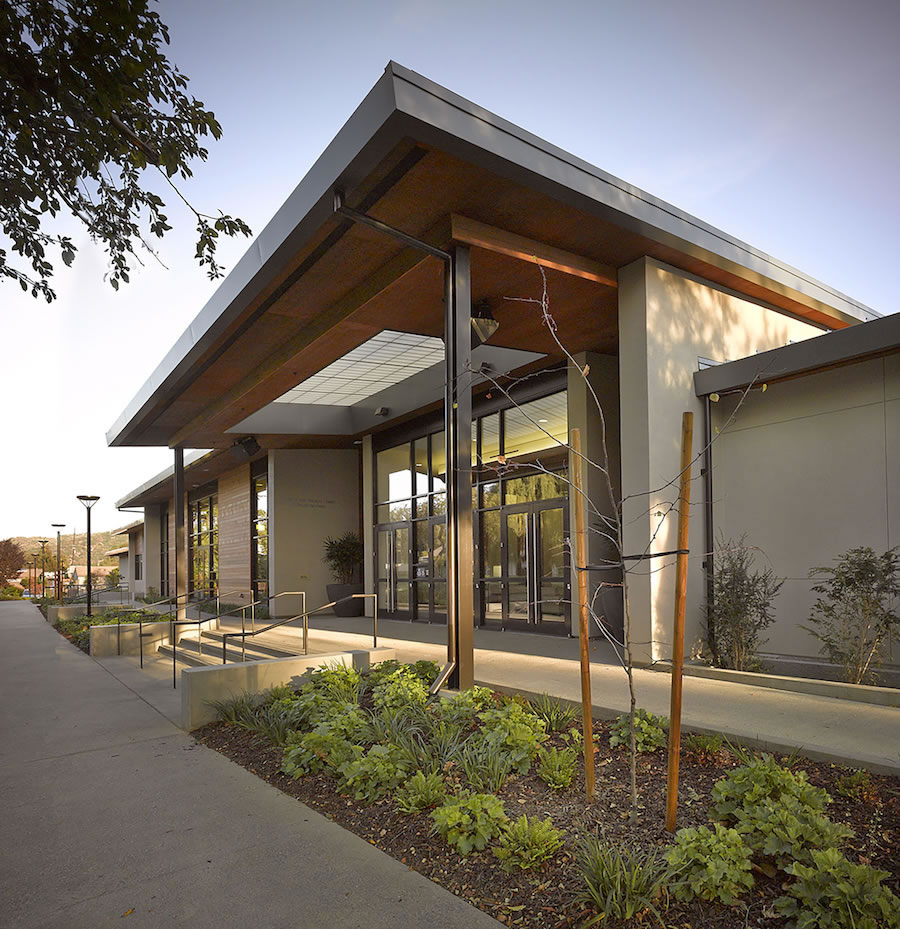Guide Dogs for the Blind raises service dogs and provides training to approximately 350 visually impaired people each year across two campuses in California and in Oregon, at no charge. On the San Rafael campus, Studio Bondy Architecture designed a new student residence that houses guest rooms, community spaces, classrooms, and administrative offices. Folding forms and simple materials characterize the architecture, and deep roof overhangs, layers of glass, and day-lit corridors provide transparency and natural ventilation. “It is a serene, beautiful place for learning,” says Laura Rambin, principal at SBA.

This project challenged the architects to consider how the building would be experienced by the visually impaired.
PROJECT
LOCATION San Rafael, CA Size 35,000ft 2
Completion 2013
Cost $11.4 million
TEAM
OWNER Guide Dogs for the Blind
Owner’s Representative Greystone West
Architect Studio Bondy Architecture (formerly Starkweather Bondy)
Civil Engineer Sandis Structural Engineer Nishkian Menninger Mechanical Engineer Guttmann & Blaevoet Electrical Engineer/ Lighting Design O’Mahony & Myer
Audio-Visual Design The Shalleck Collaborative
Interior Design Gail Gordon Design
General Contractor Lathrop Construction Associates
SUPPLIERS
Glass Systems Blomberg, SAFTI fire rated glazing, PPG glazing, Kalwall Air/Weather Barrier Stego Wrap, Fortifiber Sealants BASF, Dow Roofing Firestone TPO, AEP Span metal roofing Waterproofing Carlisle, Greenguard
Acoustical Ceilings USG, Wall Technology
Acoustical Systems Quiet Technology Systems Wall Panels
Lighting Lightolier, Wellmade, Shaper, Bega, Focal Point, Del Ray, Beta, Williams
HVAC Carrier, Reznor Window Coverings Mecho Shade
Flooring Nora, Roppe, Burke, Tandus, Tera-Lite Paint Sherwin Williams
STRATEGIC SUSTAINABILITY & COMMUNICATION
Although LEED certification was an initial goal, the non-profit chose not to pursue it in the end due to cost. “Every dollar spent is a dollar that must be donated to the organization,” Rambin says. The new building incorporates all of the sustainable features required by the California Green Building Standards Code, which is essentially equivalent to LEED Silver. In addition, it is pre-wired and pre-plumbed for future photovoltaic and solar thermal panels. Not only did the project challenge the architects to consider how the building would be experienced by the visually impaired, they also had to communicate in a new way: drawings were printed with Braille text and raised lines so that all members of the board, including those who are visually impaired, could review.
DURABLE, SUSTAINABLE MATERIALS
Since animals would be present in all areas of the building, finishes were carefully chosen for durability and sustainability. Guest suites, circulation spaces, and the dog grooming room feature stained and sealed concrete floors. The main corridor has a wainscot covered in washable wallcoverings for ease of cleaning and a handrail that aids in orientation. Exterior materials consisting of wood siding and cement plaster blend seamlessly with the existing buildings on campus and the natural wooded landscape.
MINIMIZING IMPACT, MAXIMIZING WAYFINDING
The architecture needed to integrate the new student residence within the context of the existing campus buildings and create a spatial organization that facilitated wayfinding—all while minimizing impact on existing landscaped gardens and picnic areas, including mature redwood trees. A landscaped garden between the existing administration building and the new student residence was preserved, along with the outdoor graduation area. The gardens were enhanced with new planting to provide olfactory cues to orient students on campus, and existing pedestrian paths were modified to provide accessible points of entry into the new student residence building.
HIGH-EFFICIENCY MECHANICAL SYSTEMS
Because of the intense use by animals, higher ventilation rates were a requirement for the building. Mechanical units are high efficiency with a heat recovery feature on the air side. Zoning and controls were used to make the system environmentally responsive. Additionally, mechanical systems for suites operate only when assigned to a guest who controls the thermostat. Administrative spaces and classroom VAV boxes close when rooms are unoccupied, and the assembly room has a dedicated mechanical unit that operates only during events.

